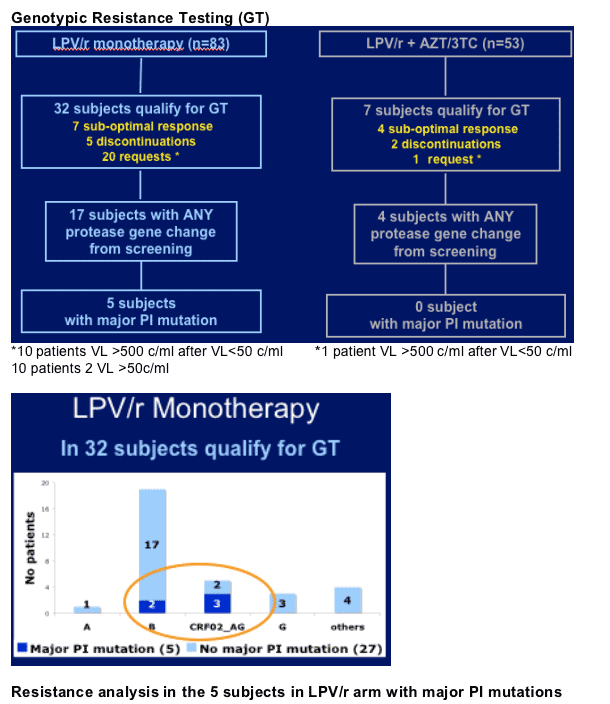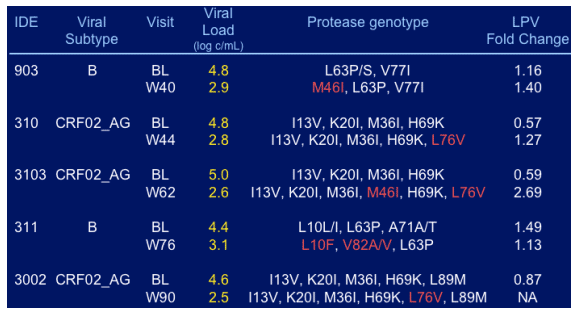 |
 |
 |
| |
Lower Barrier to Resistance with Lopinavir/Ritonavir Monotherapy
|
| |
| |
XVI International HIV Drug Resistance Workshop
June 12-16, 2007
Barbados
Mark Mascolini
Data from the MONARK trial comparing lopinavir/ritonavir monotherapy with those protease inhibitors (PIs) plus AZT/3TC in previously untreated people led investigators to conclude that the PIs given without nucleosides have a lower barrier to resistance than when given in a standard triple regimen [1].
MONARK randomized 83 antiretroviral-naive people to lopinavir/ritonavir monotherapy and 53 naive people to lopinavir/ritonavir plus AZT and 3TC. Among 131 people subtyped when the trial began, 47 (36%) had a subtype or recombinant form other than B, primarily circulating recombinant form (CRF)02, seen in 40% with non-B HIV-1. All study participants had a viral load below 100,000 copies and a CD4 count above 100 when MONARK began.
Study clinicians ordered genotyping to search for resistance mutations whenever the viral load rebounded above 500 copies or whenever they felt they needed a genotype to treat a patient appropriately. During 96 weeks of follow-up, clinicians ended up genotyping 32 people (38.5%) taking lopinavir/ritonavir alone and 7 (13.2%) taking a triple regimen. Four of the 7 genotyped people in the triple-therapy group had changes from their pretreatment protease genotype, but none of those changes involved a major PI mutation.
In contrast, 17 of 32 genotyped people (53%) in the monotherapy group had a change from their pretreatment protease sequence, and 5 of those 17 (15.6% of those genotyped) had one or more major protease mutations:
- M46I plus L63P at week 40
- L76V at week 44
- I13V plus M46I plus L76V at week 62
- L10F plus V82A at week 76
- L76V at week 90
All 3 people in whom L76V arose had CRF02_AG HIV-1, a finding leading the MONARK team to call for further study of this mutation. L76V is a critical darunavir-associated mutation but is not often seen after failure of other PIs, at least not in people infected with HIV-1 subtype B. Another Resistance Workshop study, however, found L76V along with M46I in three previously untreated people in whom lopinavir/ritonavir failed [2]. One of these three was taking lopinavir/ritonavir monotherapy, and the other two were taking standard regimens.
In the MONARK monotherapy group the latest median viral load within 4 weeks of resistance testing stood at 2.9 log (about 8000 copies) (range 2.8 to 3.1 log). The researchers saw no correlation between emergence of any mutations, including major PI mutations, and (1) pretreatment viral load or week 4 viral load, (2) CD4 count, or (3) lopinavir trough concentration.
Compared with pretreatment lopinavir 50% inhibitory concentration (IC50), the IC50 rose only 1.64-fold (range 1.13- to 2.69-fold) in 4 of the 5 people with major PI mutations who had pretreatment and rebound phenotyping. Everyone in whom a major PI mutation evolved regained a viral load below 400 copies with continued monotherapy or after adding AZT/3TC to lopinavir/ritonavir.
References
1. Delaugerre C, Flandre P, Chaix ML, et al. Protease gene mutations in a trial comparing first-line lopinavir/ritonavir monotherapy to lopinavir/ritonavir + zidovudine/lamivudine (MONARK Trial). Antiviral Therapy. 2007;12:S84. Abstract 75.
2. Nijhuis M, Wensing AMJ, Bierman W, et al. A novel genetic pathway involving L76V and M46I leading to lopinavir/ritonavir. Antiviral Therapy. 2007;12:S140. Abstract 127.
SLIDES
Protease Gene Mutations in a Trial Comparing First Line LPV/r Monotherapy to LPV/r + AZT/3TC (MONARK Trial)
C Delaugerre1, P Flandre2, ML Chaix1, P Dellamonica3,
F Raffi4, H Jaeger5, D Schurmann6, P NgoVan7, M Norton8,
I Cohen Codar7, JF Delfraissy 9 , C Rouzioux1
1Virology Necker-APHP, Paris, France; 2Inserm U720 Pierre et Marie Curie University, Paris, France; 3Infectious Diseases, Nice, France; 4Infectious Diseases, Nantes, France; 5HIV Research and Clinical Care Centre, Munich, Germany; 6Infectious Disease, Berlin, Germany; 7Abbott France, Rungis, France; 8Abbott Laboratories, New Jersey USA; 9Internal Medecine, BicÍtre-APHP, France


AUTHOR CONCLUSIONS
Five out of the 83 (6%) subjects starting LPV/r monotherapy and none of the 53 subjects starting a LPV/r-based 3 drug regimen selected major PI resistance mutation
The genetic barrier for the selection of PI resistance mutation appears to be lower with LPV/r monotherapy than with LPV/r-based 3-drug regimens
The L76V mutation emerged in 3 subjects infected with HIV-1 CRF02_AG
Full viral suppression was achieved in 3 subjects who selected a major PI mutation while on LPV/r monotherapy, after intensification with AZT/3TC
|
| |
|
 |
 |
|
|